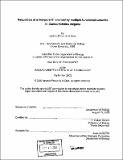Regulation of a two-pore K+ channel by multiple subunits in Caenorhabditis elegans
Author(s)
Perez de la Cruz, Ignacio, 1973-
DownloadFull printable version (9.712Mb)
Other Contributors
Massachusetts Institute of Technology. Dept. of Biology.
Advisor
H. Robert Horvitz.
Terms of use
Metadata
Show full item recordAbstract
K+ channels generate and tune the electrical signals that underlie the functioning of neurons and other excitable cells. We have studied a set of genetically-interacting genes, sup-9, sup-10 and unc-93, whose products are predicted to form a protein complex that when misregulated leads to severe muscle paralysis in the nematode C. elegans. We cloned sup-9 and found it encodes a K+ channel of the recently discovered mammalian two-pore family of voltage-insensitive leak channels, suggesting that SUP-10 and UNC-93, along with multiple UNC-93-like genes in Drosophila and humans, are the first regulatory subunits for two-pore K+ channels. Based on pharmacological data, we propose that gain-of-function mutations in the sup-9 channelor in its proposed subunits result in muscle paralysis through excessive K+ efflux and hyperpolarization of muscle cells. We cloned sup-18, a regulator of the channel complex, and show that SUP-18 is a type-three transmembrane protein that colocalizes with SUP-9 in muscle membranes and whose intracellular domain is similar to bacterial NADH nitroreductases that use an FMN cofactor. We identified a mutation in a predicted FMN-binding residue of SUP-18 that both eliminates its in vivo function without disrupting its membrane localization and that impairs the enzymatic activity of a related Thermophilus enzyme, suggesting that SUP-18 may couple cell metabolism with membrane excitability. (cont.) Through genetic and molecular studies, we determined that the SUP-10 subunit acts together with SUP-18 to activate the SUP-9 channel through a novel conserved domain in SUP-9. This domain is not required for the activation of SUP-9 by UNC-93, thus defining two independent modes of activation for a two-pore channel by multiple subunits. We also discovered a second domain in SUP-9, conserved in the human TASK-1 and TASK-3 channels, that integrates multiple regulatory inputs. Finally, our analysis of the subcellular localization of other C. elegans two-pore channels suggests that they can be differentially targeted within the cell membrane of muscle cells.
Description
Thesis (Ph.D.)--Massachusetts Institute of Technology, Dept. of Biology, 2002. Includes bibliographical references.
Date issued
2002Department
Massachusetts Institute of Technology. Department of BiologyPublisher
Massachusetts Institute of Technology
Keywords
Biology.